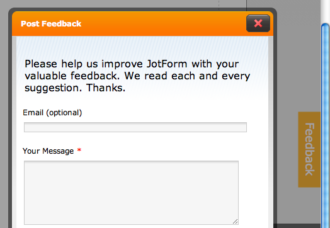I re-read the comment on our support thread:
“Over the years, it seems to me that Jotform has become slower and less responsive to user requested functionality improvements.”
Ouch.
It wasn’t the most uplifting thing I’d read that day. And I’ll admit, it stung for a moment.
But I could also see that this user had a fair point.
We were in the middle of rolling out Jotform Cards, and things were manically busy. As a result, we needed more time than usual to evaluate all those feature requests.
I replied to the comment personally and reached out to the customer right after via email, doing my best to explain the situation and offer a solution.
But it drew attention to something we needed to know: what it was like, for this person, to use Jotform. And that made it valuable. Because as developers (or designers, or writers…), no matter how hard we try, we will always have a blind spot.
So, when someone offers us that mirror, in the form of feedback, it’s a gift: no matter who we are, what we do or how much we’ve achieved.
But this feedback has to be effective.
Feedback is effective when it sheds light on the present and offers a window into the future — without dwelling on the past.
Feedback isn’t effective when it inflates — or bruises — someone’s ego.
Finding this sweet spot is incredibly tricky. Feedback-givers need to toe a (sometimes paper-thin) line between explaining and preaching, sensitivity and sugar-coating, impartiality and personal blame.
Emotions, histories, fears, over-justifications — these boulders tend to trip us up.
So how can we cut through the noise and learn to deliver feedback that is genuinely helpful?
Here’s what I’ve learned across 12 years of building a product for 3.5 million users and managing feedback with our team of 100 employees:
Should I, or shouldn’t I?
Not every little slip-up needs to be pointed out, let alone rubbed in.
But when something keeps recurring, it risks becoming a habit.
Hence my first rule of feedback: it needs to be pattern-based. It may be about a detail, but if that detail’s repeated, it becomes part of the bigger picture.
Focusing on patterns also alleviates recency bias (when we over-emphasize events because they happened in our near-term memory).
That’s why that Jotform user’s feedback resonated with me: he was commenting pattern that had developed over the years, not a random one-off.
And that made me sit up and pay attention.
The negative-to-positive ratio
What type of feedback is more effective: constructive criticism or positive motivation?
Positive feedback is the ultimate motivator. It spurs people to continue doing what they’re doing well, with more vigor, creativity and enthusiasm.
But it’s also true that most people find it easier to notice what’s going wrong than what’s going right. Success fades easily into the background, while mistakes leap out at us.
And it shows:
A recent Harvard study found that while 21% of leaders avoid giving negative feedback, 37% don’t give positive reinforcement at all.
But research shows that highlighting employees’ accomplishments leads to significantly higher engagement; and that delivering only negative feedback diminishes a leader’s effectiveness in the eyes of others.
So it’s important to train ourselves to notice what others (whether it’s our employees, our spouse or our children) are doing right, or well, or well enough.
Positive feedback shows people you’re in their corner, that you believe in them, and want them to succeed.
But while positive feedback may be the best motivator, it can’t be the only one.
Like yin and yang, positive encouragement and constructive criticism need to balance each other out.
So what’s the perfect mix?
Apparently, the ratio between positive and negative feedback should be 5.6 (or nearly six positive comments for each negative one).
A little negativity (and a lot of positivity) goes a long way.
1. How to give positive feedback
It can be brief. It can be simple. But it must be more heartfelt than a throwaway ‘Good job’ remark.
It’s easy to assume people know when they’ve nailed it; but 71% of people say that they appreciate recognition for a job well done. And if results aren’t acknowledged, they stay open to interpretation.
Instead, articulating someone’s accomplishments stimulates the reward centres in the brain; this creates motivation and leaves the recipient open to constructive suggestions.
It’s crucial that positive comments are not fluffy bits of flattery, but genuine observations. They should reflect back someone was actually doing, not who they are: in other words, their effort, not ability.
So, highlight aspects of someone’s performance that were under their control — their planning, their creative ideas, their dedication — over qualities they were born with (‘You’re so smart’).
As Heidi Grant Halvorson summarizes:
“Praise the process, not the person. That way, when he runs into trouble later on, he’ll remember the process that helped him to succeed in the past, and put that knowledge to good use”.
2. How to give negative feedback
Receiving negative feedback triggers something powerful in us.
It’s a primal thing: ever since our caveman beginnings, our brains have fought to protect us from predators.
Today, that predator might be a slew of critical observations rather than a woolly mammoth, but our instinct to fight back is just as strong: our most deep-rooted desires for safety and security are threatened, alongside our precious self-esteem.
We feel personally attacked. We get defensive. We block the words out.
Most of us have been on the receiving end of negative feedback and experienced these reactions firsthand.
And that’s why it’s so tough to deliver it to someone else: no one likes causing hurt, or embarrassment, or anxiety.
And so, we tiptoe around the issue. Or we tuck harsh criticism between false platitudes.
We make it ‘thinly-veiled criticism’ — negative feedback delivered in a kind, polite voice. We open with “I like your work but ….” before launching into a long list of things that we don’t like.
Or we avoid duck out of giving negative feedback altogether.
None of this works. People aren’t stupid.
They will still hear your negative message; with the added blow of feeling patronized or subtly attacked. They will trust you a little less.
And withholding the truth to protect someone’s feelings — even with the best intentions — is cruel: you’re robbing them the opportunity to learn, grow and improve. Without this, they lose personal responsibility for their actions; they become powerless.
Plus, when you brush small issues under the carpet, you’re allowing these issues to pile up until they become a Big Problem.
And when you’re forced to address it, the recipient is going to have one question: “why didn’t you say anything before?”
The alternative
Put the ball in their court. Let them nip the issue in the bud (before it balloons out of control.) Show you consider them an equal by being candid. Honesty and transparency are huge indicators of respect.
Remember, painful emotions exist for a reason: they spur us into action.
Sure, it will still hurt, briefly.
And then they will get over it.
Essential qualities of effective feedback
How we frame feedback, positive or negative, has a massive impact on how it’s received. Here’s how to frame it so that it’s heard — and acted on.
1) Make it specific
Why do crossed wires and misunderstandings happen? Because of vague, wishy-washy feedback. To be specific, feedback must be factual and action-based.
- Factual: Saying ‘He lacks confidence’ or ‘She’s too loud’ is just one person’s interpretation of another’s behavior. People are complex, and commenting on who they are is not only likely to make them defensive, but it will inevitably result in unhelpful generalities. Keep it factual, and keep your personal feelings at bay.
- Action-based: Bandying around general adjectives like ‘great’ or ‘helpful’ is pointless: what did they do that was helpful or great? Link everything back to actions and outcomes: when you reflect on these, discussing detail happens naturally: what’s not working here? How can we change this?
By telling someone they have failed on a general level, you’re reinforcing a fixed mindset that says there’s no point trying.
But if you reflect back specific behavior and actions that can be fixed, you encourage a growth-orientated mindset.
2) Make it actionable
Feedback works best when it doesn’t dwell on the issue that needs to be improved, but focuses instead on how it can be improved.
Problems should be presented arm-in-arm with a solution, a raft to jump onto, a clear path to follow. This gives people a chance to direct their energy towards positive change (and hopefully distracts from any hurt feelings).
Emphasize actions that they have the power to change themselves. Then, give them the tools to propel themselves in the right direction.
For example, “You need to be more accountable to your team” is too open to interpretation to be actionable, whereas “I’d like you to provide weekly reports about the progress you’ve made,” drills down to the root of the problem and points to a specific way of addressing it.
3) Focus on a shared goal
Setting clear goals is a natural companion of actionable feedback:
“Effective feedback requires that a person has a goal, takes action to achieve the goal, and receives goal-related information about his or her actions.
Information becomes feedback if, and only if, I am trying to cause something and the information tells me whether I am on track or need to change course.” explains author Grant Wiggin.
Saying “You need to improve the design on that presentation” is tricky to implement.
“You need to change this part of the presentation, so that we have time to proofread before we present it on Tuesday” creates focus, informs a shared goal, and relates back to the bigger picture.
4) Make it manageable, make it routine
Long lists create overwhelm. Complexity stresses people out. So keep it simple, so that the other person can wrap their head around what you’re saying.
And keep the focus of your feedback on one or two issues; when they’ve been addressed, you can move onto the next.
Feedback is far more likely to cause stress and bruise feelings when it comes out of the blue. Instead, remove the fear-factor by making it a regular, No Big Deal occurance.
As people start to expect feedback on a continuous basis, anxiety around it will diminish and criticisms will become easier to digest.
As Ed Batista, executive coach and instructor at the Stanford Graduate School of Business, highlights:
“If you’re having a feedback conversation every week, there’s less to be surprised by and more opportunity to modify your behavior,”
5) Keep it neutral
Other people evoke emotions in us — positive or negative. They just do. It’s part of being human.
But whatever feelings someone brings up in us, this shouldn’t have any impact on the feedback we give them. Emotion adds a charge that will cloud the message.
Effective feedback needs to be non-biased and descriptively focused on behavior or outcomes.
If not, it risks slipping into what psychologist Dr. Christian Jarrett calls ‘destructive criticism’ — personal, harsh in tone and potentially humiliating.
Profuse admiration can be equally ineffective. It sets a high expectation without translating this into an achievable action. This often has more to do with our personal preferences than anything else.
For instance, if someone says “He has a great sense of humor,” they’re really saying “Her sense of humor matches mine.”
6) Make it a dialogue
Some of the least effective feedback I’ve received came in the form of an endless monologue. When we are talked at, our eyes glaze over, and our minds shut down.
Making space for the other person to talk will help them open up. Consider leading with a question:
How do you feel the meeting went today? How do you see the situation? How might you do things differently next time? What do you think worked, and what could have gone better?
Effective feedback aims to change someone’s behavior for the better. But the other person will only be receptive to change if they believe that you have their best interests at heart. That starts with being open-minded.
You can have a bible full of facts and deliver it with awesome skill — and still get it wrong. What’s at stake may merely be a matter of opinion. We’re all human, and that means we have conflicting values, perspectives, and feelings.
So hear the other person out. Listen to what they come back with.
Consider the possibility that you might have got it wrong, or that the truth might be located somewhere in the middle ground.
7) Link it to consequences
If I tell a member of staff at Jotform that she is a creative UX designer who’s great at problem-solving, she will probably feel flattered — and not much else.
But, if I say her creative ideas during our latest hack week motivated her teammates, or that her problem-solving skills shed light on a new direction for our product, she will be able to form a link between herself and the impact she has.
This is both empowering and inspiring.
And it works both ways. When you’re invested in a person or team’s performance, it can be tempting to pick up their slack to avoid negative results. But this will only encourage complacency and reinforce bad habits.
Instead, let natural consequences occur, and if necessary, remind people of the impact their actions have on the bigger picture. Sometimes, a bit of pressure is what’s needed to shift people into action.
In short:
Feedback should be:
- Pattern-based
- Both positive and negative (six-to-one ratio)
- Specific
- Actionable
- Goal-orientated
- Manageable and regular
- Neutral
- Dialogue-driven
- Linked to consequences
Feedback is one of the greatest gifts any of us can receive. It inspires change, empowers us, spurs us into action.
That’s why learning to deliver it effectively is one of the most important — and the most challenging — part of any leaders job.
As Sam Walton put it: “Outstanding leaders go out of the way to boost the self-esteem of their personnel. If people believe in themselves, it’s amazing what they can accomplish.”
At its very core, effective feedback builds a bridge into the future. It sets out a clear path to follow. And it says, with conviction:
‘I believe you can get there.’
























Send Comment:
2 Comments:
More than a year ago
Awesome post!!
More than a year ago
Such a great post. Congrats!